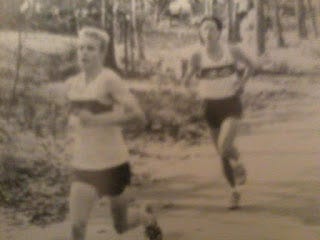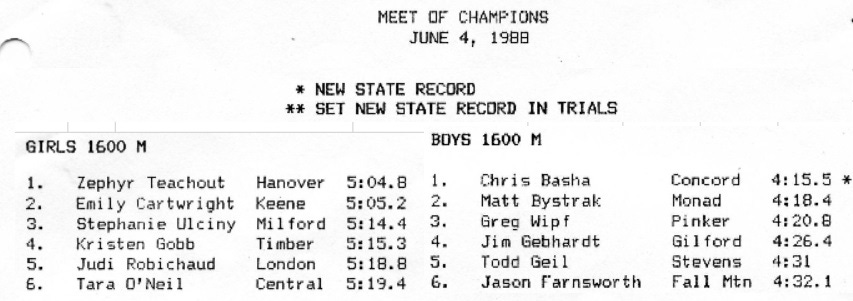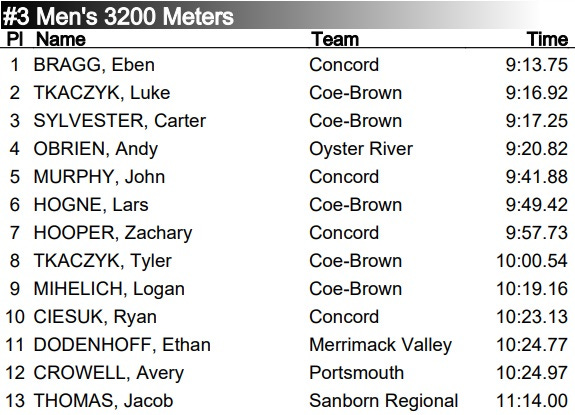Every good broken record includes dust, skips and unclear numbers
Plus a new Concord High mark in the U20 category.
Most of what I write about here falls into one of three categories: Me, People Who Annoy Me, and Fast Kids. This is a fairly common triad, or would be if there were more gregariously dyspeptic male runners over fifty with time to burn over food-encrusted laptops.
I was going to dedicate this post to the last leg of my road trip, between Ogden, Utah and here, but because my mother arrived in Boulder on Saturday, the day after I got back, that trip is in effect still continuing; I’ll be traveling around the state for the next five days, in some cases to places I haven’t been to myself. So that topic has briefly been placed on ice. At present, I also don’t feel like chronicling the grifting and dissembling of People Who Annoy Me any more than most of you feel like reading about their dubious machinations, though I already have the usual bullet points in place in preparation for the next round of sniping. So Fast Kids it is today, with an obligatory dose of Me (or really, Us).
In my last update in this vein, I argued that Eben Bragg’s 4:15.61 in the 1,600 meters on May 7 had not broken Chris Basha’s Concord High School record of 4:15.5 from the 1988 New Hampshire Meet of Champions, at which I competed as Basha’s teammate:
After the race, there was some scuttle in the Concord camp that if Basha’s record was a hand-timed mark, then the corresponding FAT mark would be 4:15.74, giving Bragg the new record. This, however, incorporates the incorrect assumption that the conversion factor of 0.24 used for the 100-meter and 200-meter dashes applies to all track events, when in fact, for the 800 meters on up, no further conversion is needed after rounding up the hand-timed mark to the nearest tenth of a second. (For the 300-meter intermediate hurdles and the 400 meters, a conversion of 0.14 is used.)
I defended this by referring to the standards used by T&F News and most of the world. If you look at that linked page, however, you’ll also see that the National Federation of High Schools (NFHS) suggests adding 0.24 seconds to all hand-timed events, regardless of distance. It doesn’t say, but to my eyes implies, that times from decades ago make an especially good target for this option.
After reading my post, John Goegel, who coached me and Chris in the winter of 1988, challenged me on this assertion, and rightly so. Importantly—and I was hoping one of the old Granite State coaching goats would produce data here—John pointed me to the archived results of all of the Division I and Meet of Champions results between 1976 and 1998 (Lancer Timing has the ones from 1999 on). I didn’t know these existed, but they do, and while ugly and not entirely complete, they reinforced just how primitive the technology at even state championship meets could be in those days. You can see that even the sprint times from the 1988 MoC are given only to the tenth of a second.
This is clearly a meet at which I would, reversing course, apply the NFHS rules and thus, at least symbolically, award Bragg the new record by fixing Chris’s time at 4:15.74. But until Bragg breaks 4:15.50, I would keep Chris’s name on any official lists maintained at the school, including on private laptops. And I have a ton of moles, spies and leakers in that community going back decades lest anyone try to cheat, should this become an issue.
Seeing the 1988 MoC results and other names and times from those days in the form I first viewed them, on sheets of paper printed before the Soviet Union was dissolved, filled me with a sense of something that I can’t quite call nostalgia, because nostalgia carries the scent of something unreachable and forlorn, even if the overall memory is fond. No, this sense has too many tentacles grasping at the present, and there is nothing sad about it, what with Bragg, his Concord teammates, other New Hampshire kids, and young runners nationwide now running so well despite we* adults blanketing their efforts in a fog of strange rules and hysterical cultural imperatives.
(Don’t be distracted by any especially distinctive names you see in that image.)
I have access to a DVD of the whole meet, but it’s worth describing the race briefly. Jim Gebhardt took it out in under 60 seconds, which basically ruined the race for all but three runners. I think Chris, who hated not leading track races from the opening steps, was at around 61. I think Gebhardt was still in the lead at 800 in 2:04-point, but I remember Chris leading for at least the last 600 and gradually opening his lead.
What I do remember clearly is how exciting it was to see a friend and rival finish off the last day of my in-state high-school career with a killer performance. (He would go on to win the 800 meters as well that day.) Chris himself had another year of high school left, and despite a stress fracture that kept him on an exercise bike for much of his senior spring, he repeated his wins at the D1 and MoC in the 1,600 meters, the latter by a tenth of a second.
I have had discussions over the years with coaches far more experienced and wiser than I’ll ever be about the could-have-beens with Chris, talks that are naturally rekindling themselves now. He was a monumental talent that no one person failed, but who didn’t have the sort of system around him that would have allowed him to flourish after high school. He accomplished what he did on intense but remarkably sparse training, and he remains probably the most talented distance runner ever to walk the halls of CHS.
He was a sweet kid who hated only one thing: Losing. I did too, but in running I had the excuse of being used to it from the start (my first official time was 21:06), until I got good enough as a senior to beat Chris a number of times on cross-country courses.

If Chris had not moved to Concord before my junior year, my memories of those days would be deeply impoverished for it. My senior year, I completely avoided the 1,600 meters and Chris the 3,200 meters because neither wanted to lose to the other and die fighting on the ground to prevent that in a meaningless dual meet. In reality, he could have crushed me in the 3,200 as well, but I don’t think he believed this. He was also busy dominating two other events.
Anyway, pretending that Bragg is still 0.11 seconds shy of the school mark in the 1,600 meters, this means that he is now a combined 2.20 seconds short of holding the school records in both distance events. Last Friday, this happened:
You can watch the race (and others from Mini Meet #5) here, where you can verify that Bragg’s splits were about 71, 71, 69.5, 70 (4:41.5), 70.5, 72., 69.5, ~60 (~4:32). I’ve been wrong before, but when a kid has a 60-second last lap in him off that kind of a pace, he’s probably got the ability to run under 9:00 in a well-paced race, if not now then by the time the season ends. But probably now.
The CHS record is 9:11.62, set by Guor Marial (then Majak) in 2004. The whole of Marial’s story is compelling, including his 2:12:55 marathon and his competing in the 2012 Olympic Marathon as an Independent Olympic Athlete. But as you can see from his Wikipedia page, he was also 20 years old (as a junior) when he set that record, and close to 21 when he won the 2005 National Indoor Championship 2-Mile. It’s kind of hard to overlook that, but I think Bragg will soon add the overall school record in the 3,200 meters to the U20 record he now already has.
What qualifies as a “state record” in New Hampshire?
I’m not done talking out of my ass just yet. Most of which follows can be accepted as fact, but only because no one can definitively disconfirm any of it.
In the 1980s, in order to be credited with a high-school state record, an athlete had to record that mark that the Meet of Champions, held one week after the D1, D2 and D3 state meets. Correspondingly, divisional records had to be set at a divisional state meet. Back then, this made a certain amount of sense; most smaller meets were hand-timed, some in the north country with sundials and practically no witnesses, and if it didn’t make sense to accept a 10.7 for the 100-meter dash at a dual meet between Profile and Lin-Wood, accepting far more plausible marks in distance events also had to be a no-go. Also, other than the New England Championships, New Hampshire’s most talented tracksters rarely competed outside the state’s borders. This is why Basha’s school record also stood as a state record despite at least one known superior performance (a 4:13.64 mile).
When, sometime in the mid-1990s, FAT became more of a standard feature at midseason invitationals (then only beginning to blossom in the Granite State). marks from non-championship races became countable. I’m not sure entirely which ones, but the first person I remember breaking Basha’s record was Zak Wright of Conant, who ran 4:14.75 at the 1994 Meet of Champions, But Wright, who still holds the state record in the 1,000 meters with a 2:27.38, left high school with a PR of 4:11.57, which was listed as the state record for a while. John Mortimer ran 4:10.84 for an indoor mile in 1995, worth a 4:09.39 1,600 meters, but the only corresponding indoor event in New Hampshire is the 1,500 meters. Jason Vanderhoof ran a 3:50.99 outdoor 1,500 meters, also in 1995; this is worth a 4:08.08 1,600 meters, but can’t be counted as any kind of state record. Francis Hernandez is the current holder of the record with a 4:07.76, converted from a 4:09.21 full mile run out-of-state.
Although current standards reportedly require only that state records be set in-season (that is, no later than the New England Championships), with the location of venue irrelevant, this is not borne out in the boys’ and girls’ records listed on New HampshireTrackAndField.com. While the requirement that a divisional record be set at a divisional state meet is straightforward (it’s just one more kind of meet record), I see that Aaron Watanabe’s 8:59.43 from the 2010 New England Championships in Connecticut is listed as the 3,200-meter record, even though Elijah Moskowitz ran 8:44.79 at the 2015 Loucks Games in New York. There may be other discrepancies on these lists, but whenever I see that 8:44.79, I wonder if Moskowitz is the only kid in history to run under 8:45 without recording a single other sub-9:10 at the distance, especially given how early in his senior year he did it.
The next and final Elite Mini Meet, #6, takes place on Friday and features another 1,600 meters. I have some idea of what the goal is for at least one athlete involved and his planned path for getting there, and I have a good idea of how things will play out if the weather cooperates. And I am hoping to chase my mom back to New Hampshire so I can catch the D1 meet on May 29 and the Meet of Champions on June 5 in person. Mostly though, that trip will be about reconnecting with a lot of similarly wizened and beat-up joggers who think about all of the above things and more to gross excess.



